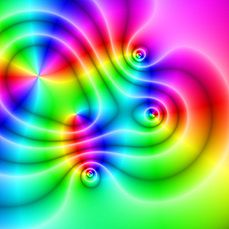- Complex analysis
-
 Plot of the function f(x)=(x2 - 1)(x - 2 - i)2/(x2 + 2 + 2i). The hue represents the function argument, while the brightness represents the magnitude.
Plot of the function f(x)=(x2 - 1)(x - 2 - i)2/(x2 + 2 + 2i). The hue represents the function argument, while the brightness represents the magnitude.
Complex analysis, traditionally known as the theory of functions of a complex variable, is the branch of mathematical analysis that investigates functions of complex numbers. It is useful in many branches of mathematics, including number theory and applied mathematics; as well as in physics, including hydrodynamics, thermodynamics, and electrical engineering.
Murray R. Spiegel described complex analysis as "one of the most beautiful as well as useful branches of Mathematics".
Complex analysis is particularly concerned with the analytic functions of complex variables (or, more generally, meromorphic functions). Because the separate real and imaginary parts of any analytic function must satisfy Laplace's equation, complex analysis is widely applicable to two-dimensional problems in physics.
Contents
History
Complex analysis is one of the classical branches in mathematics with roots in the 19th century and just prior. Important names are Euler, Gauss, Riemann, Cauchy, Weierstrass, and many more in the 20th century. Complex analysis, in particular the theory of conformal mappings, has many physical applications and is also used throughout analytic number theory. In modern times, it has become very popular through a new boost from complex dynamics and the pictures of fractals produced by iterating holomorphic functions. Another important application of complex analysis is in string theory which studies conformal invariants quantum field theory.
Complex functions
A complex function is one in which the independent variable and the dependent variable are both complex numbers. More precisely, a complex function is a function whose domain and range are subsets of the complex plane.
For any complex function, both the independent variable and the dependent variable may be separated into real and imaginary parts:
 and
and
- where
 and
and  are real-valued functions.
are real-valued functions.
In other words, the components of the function f(z),
 and
and
can be interpreted as real-valued functions of the two real variables, x and y.
The basic concepts of complex analysis are often introduced by extending the elementary real functions (e.g., exponentials, logarithms, and trigonometric functions) into the complex domain.
Holomorphic functions
Main article: Holomorphic functionHolomorphic functions are complex functions defined on an open subset of the complex plane that are differentiable. Complex differentiability has much stronger consequences than usual (real) differentiability. For instance, holomorphic functions are infinitely differentiable, whereas some real differentiable functions are not. Most elementary functions, including the exponential function, the trigonometric functions, and all polynomial functions, are holomorphic.
See also: analytic function, holomorphic sheaf and vector bundles.
Major results
One central tool in complex analysis is the line integral. The integral around a closed path of a function that is holomorphic everywhere inside the area bounded by the closed path is always zero; this is the Cauchy integral theorem. The values of a holomorphic function inside a disk can be computed by a certain path integral on the disk's boundary (Cauchy's integral formula). Path integrals in the complex plane are often used to determine complicated real integrals, and here the theory of residues among others is useful (see methods of contour integration). If a function has a pole or singularity at some point, that is, at that point where its values "blow up" and have no finite boundary, then one can compute the function's residue at that pole. These residues can be used to compute path integrals involving the function; this is the content of the powerful residue theorem. The remarkable behavior of holomorphic functions near essential singularities is described by Picard's Theorem. Functions that have only poles but no essential singularities are called meromorphic. Laurent series are similar to Taylor series but can be used to study the behavior of functions near singularities.
A bounded function that is holomorphic in the entire complex plane must be constant; this is Liouville's theorem. It can be used to provide a natural and short proof for the fundamental theorem of algebra which states that the field of complex numbers is algebraically closed.
If a function is holomorphic throughout a simply connected domain then its values are fully determined by its values on any smaller subdomain. The function on the larger domain is said to be analytically continued from its values on the smaller domain. This allows the extension of the definition of functions, such as the Riemann zeta function, which are initially defined in terms of infinite sums that converge only on limited domains to almost the entire complex plane. Sometimes, as in the case of the natural logarithm, it is impossible to analytically continue a holomorphic function to a non-simply connected domain in the complex plane but it is possible to extend it to a holomorphic function on a closely related surface known as a Riemann surface.
All this refers to complex analysis in one variable. There is also a very rich theory of complex analysis in more than one complex dimension in which the analytic properties such as power series expansion carry over whereas most of the geometric properties of holomorphic functions in one complex dimension (such as conformality) do not carry over. The Riemann mapping theorem about the conformal relationship of certain domains in the complex plane, which may be the most important result in the one-dimensional theory, fails dramatically in higher dimensions.
See also
- Complex dynamics
- List of complex analysis topics
- Real analysis
- Runge's theorem
- Several complex variables
Notes
References
- Ahlfors.,Complex Analysis(McGraw-Hill).
- C.Caratheodory, Theory of Functions of a Complex Variable (Chelsea,New York). [2 volumes.]
- Needham T., Visual Complex Analysis (Oxford, 1997).
- Henrici P., Applied and Computational Complex Analysis (Wiley). [Three volumes: 1974, 1977, 1986.]
- Kreyszig, E., Advanced Engineering Mathematics, 9 ed., Ch.13-18 (Wiley, 2006).
- A.I.Markushevich.,Theory of Functions of a Complex Variable(Prentice-Hall, 1965).[Three volumes.]
- Scheidemann, V., Introduction to complex analysis in several variables (Birkhauser, 2005)
- Shaw, W.T., Complex Analysis with Mathematica (Cambridge, 2006).
- Spiegel, Murray R. Theory and Problems of Complex Variables - with an introduction to Conformal Mapping and its applications (McGraw-Hill, 1964).
- Marsden & Hoffman, Basic complex analysis (Freeman, 1999).
External links
- Complex Analysis -- textbook by George Cain
- Complex analysis course web site by Douglas N. Arnold
- Example problems in complex analysis
- A collection of links to programs for visualizing complex functions (and related)
- Complex Analysis Project by John H. Mathews
- Wolfram Research's MathWorld Complex Analysis Page
- Application of Complex Functions in 2D Digital Image Transformation
- Complex Visualizer - Java applet for visualizing arbitrary complex functions
- JavaScript complex function graphing tool
- Earliest Known Uses of Some of the Words of Mathematics: Calculus & Analysis
Categories:
Wikimedia Foundation. 2010.

